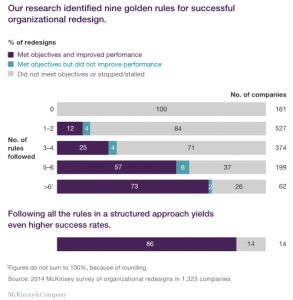Companies will better integrate their people, processes, and structures by following nine golden rules.
Recent McKinsey research surveying a large set of global executives suggests that many companies, these days, are in a nearly permanent state of organizational flux. Almost 60 percent of the respondents, for example, told us they had experienced a redesign within the past two years, and an additional 25 percent said they experienced a redesign three or more years ago. A generation or two back, most executives might have experienced some sort of organizational upheaval just a few times over the course of their careers. One plausible explanation for this new flurry of activity is the accelerating pace of strategic change driven by the disruption of industries. As a result, every time a company switches direction, it alters the organization to deliver the hoped-for results. Rather than small, incremental tweaks of the kind that might have been appropriate in the past, today’s organizations often need regular shake-ups of the Big Bang variety.
Frustratingly, it also appears that the frequency of organizational redesign reflects a high level of disappointment with the outcome. According to McKinsey’s research, less than a quarter of organizational-redesign efforts succeed. Forty-four percent run out of steam after getting under way, while a third fail to meet objectives or improve performance after implementation. The good news is that companies can do better—much better. In this article, we’ll describe what we learned when we compared successful and unsuccessful organizational redesigns and explain some rules of the road for executives seeking to improve the odds. Success doesn’t just mean avoiding the expense, wasted time, and morale-sapping skepticism that invariably accompany botched attempts; in our experience, a well-executed redesign pays off quickly in the form of better-motivated employees, greater decisiveness, and a stronger bottom line.
Why redesign the organization?
Organizational redesign involves the integration of structure, processes, and people to support the implementation of strategy and therefore goes beyond the traditional tinkering with “lines and boxes.” Today, it comprises the processes that people follow, the management of individual performance, the recruitment of talent, and the development of employees’ skills. When the organizational redesign of a company matches its strategic intentions, everyone will be primed to execute and deliver them. The company’s structure, processes, and people will all support the most important outcomes and channel the organization’s efforts into achieving them.
When do executives know that an organization isn’t working well and that they need to consider a redesign? Sometimes the answer is obvious: say, after the announcement of a big new regional-growth initiative or following a merger. Other signs may be less visible—for example, a sense that ideas agreed upon at or near the top of the organization aren’t being translated quickly into actions or that executives spend too much time in meetings. These signs suggest that employees might be unclear about their day-to-day work priorities or that decisions are not being implemented. A successful organizational redesign should better focus the resources of a company on its strategic priorities and other growth areas, reduce costs, and improve decision making and accountability.
The case of a consumer-packaged-goods (CPG) company that chose to expand outside its US home base illustrates one typical motivation for a redesign. Under the group’s previous organizational structure, the ostensibly global brand team responsible for marketing was not only located in the United States but had also been rewarded largely on the performance of US operations; it had no systems for monitoring the performance of products elsewhere. To support a new global strategy and to develop truly international brands and products, the company separated US marketing from its global counterpart and put in place a new structure (including changes to the top team), new processes, new systems, and a new approach to performance management. This intensive redesign helped promote international growth, especially in key emerging markets such as Russia (where sales tripled) and China (where they have nearly doubled).
By Steven Aronowitz, Aaron De Smet, and Deirdre McGinty
More: https://www.mckinsey.com/
